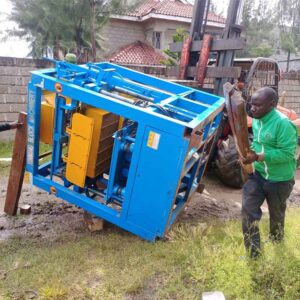
Title: **Greening the Manufacturing Line: Strategies for Enhancing Full-Automatic Block Machine Energy Efficiency**
Introduction:
In the pursuit of sustainable and environmentally conscious manufacturing practices, energy efficiency has become a focal point for industries worldwide. The full-automatic block manufacturing sector, driven by precision and automation, can significantly contribute to sustainability goals by optimizing energy consumption. This article explores strategies aimed at enhancing the energy efficiency of full-automatic block machines, aligning production processes with eco-friendly principles.
1. **Adoption of Energy-Efficient Technologies:**
Investing in the latest energy-efficient technologies is a fundamental strategy for optimizing full-automatic block machine energy consumption. Upgrading motors, sensors, and control systems to more energy-efficient variants can lead to substantial reductions in overall energy use. Additionally, the integration of variable frequency drives (VFDs) allows for better control and modulation of energy usage based on production requirements.
2. **Optimizing Machine Design and Layout:**
The design and layout of the full-automatic block machine play a pivotal role in energy efficiency. Optimizing the machine’s configuration to minimize unnecessary movements, reduce friction, and enhance the overall mechanical efficiency can result in significant energy savings. Engineers should focus on streamlining the production process and eliminating any design elements that contribute to energy wastage.
3. **Heat Recovery Systems:**
Full-automatic block machines often generate heat during operation, especially in the curing process. Implementing heat recovery systems can capture and reuse this excess heat for other purposes within the manufacturing facility. This not only conserves energy but also reduces the reliance on external heating sources, contributing to a more sustainable production process.
4. **Energy-Efficient Materials and Mixtures:**
The composition of the concrete mix used in full-automatic block production can impact energy efficiency. Exploring the use of energy-efficient materials, such as recycled aggregates or alternative cement blends, can contribute to lower energy requirements during the mixing and curing stages. Additionally, optimizing the mix design to reduce the overall weight of the blocks without compromising structural integrity can lead to energy savings throughout the production process.
5. **Precision Control and Automation:**
Enhancing precision control and automation in full-automatic block machines is instrumental in minimizing energy waste. Precise control over the movements of robotic arms, conveyor systems, and other components reduces unnecessary energy consumption. Implementing advanced control algorithms that adjust parameters based on real-time production demands ensures that energy is used efficiently without compromising production speed or quality.
6. **Energy Monitoring and Management Systems:**
Implementing energy monitoring and management systems provides real-time insights into the energy consumption patterns of full-automatic block machines. These systems can identify areas of inefficiency and highlight opportunities for improvement. By continuously monitoring energy usage and setting benchmarks, manufacturers can implement targeted strategies to optimize energy performance.
7. **Employee Training and Awareness:**
The human element is crucial in ensuring energy-efficient practices on the manufacturing floor. Conducting training programs to educate machine operators and maintenance personnel about the importance of energy conservation, as well as providing guidelines on optimal machine operation, contributes to a culture of energy awareness and responsibility.
8. **Regular Maintenance and Calibration:**
Well-maintained and calibrated machinery operates more efficiently. Regularly scheduled maintenance checks and calibration of sensors and equipment ensure that the full-automatic block machine functions optimally. Properly lubricated and aligned components experience less friction, reducing energy requirements and extending the lifespan of the machinery.
Conclusion:
Enhancing the energy efficiency of full-automatic block machines is not only an ecological imperative but also a strategic move towards sustainable manufacturing. By implementing a combination of technological upgrades, process optimizations, and employee training, manufacturers can reduce their environmental footprint while improving operational efficiency. These strategies not only align with global sustainability goals but also position the full-automatic block manufacturing industry as a leader in eco-friendly and energy-efficient construction material production.
